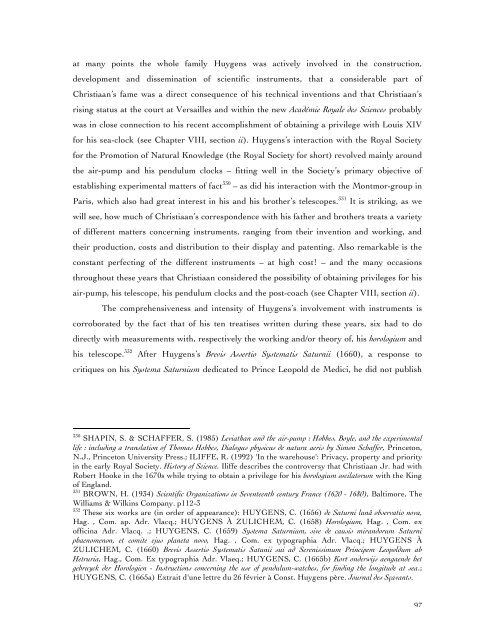Christiaan Huygens – A family affair - Proeven van Vroeger
Christiaan Huygens – A family affair - Proeven van Vroeger
Christiaan Huygens – A family affair - Proeven van Vroeger
You also want an ePaper? Increase the reach of your titles
YUMPU automatically turns print PDFs into web optimized ePapers that Google loves.
at many points the whole <strong>family</strong> <strong>Huygens</strong> was actively involved in the construction,<br />
development and dissemination of scientific instruments, that a considerable part of<br />
<strong>Christiaan</strong>’s fame was a direct consequence of his technical inventions and that <strong>Christiaan</strong>’s<br />
rising status at the court at Versailles and within the new Académie Royale des Sciences probably<br />
was in close connection to his recent accomplishment of obtaining a privilege with Louis XIV<br />
for his sea-clock (see Chapter VIII, section ii). <strong>Huygens</strong>’s interaction with the Royal Society<br />
for the Promotion of Natural Knowledge (the Royal Society for short) revolved mainly around<br />
the air-pump and his pendulum clocks <strong>–</strong> fitting well in the Society’s primary objective of<br />
establishing experimental matters of fact 330 <strong>–</strong> as did his interaction with the Montmor-group in<br />
Paris, which also had great interest in his and his brother’s telescopes. 331 It is striking, as we<br />
will see, how much of <strong>Christiaan</strong>’s correspondence with his father and brothers treats a variety<br />
of different matters concerning instruments, ranging from their invention and working, and<br />
their production, costs and distribution to their display and patenting. Also remarkable is the<br />
constant perfecting of the different instruments <strong>–</strong> at high cost! <strong>–</strong> and the many occasions<br />
throughout these years that <strong>Christiaan</strong> considered the possibility of obtaining privileges for his<br />
air-pump, his telescope, his pendulum clocks and the post-coach (see Chapter VIII, section ii).<br />
The comprehensiveness and intensity of <strong>Huygens</strong>’s involvement with instruments is<br />
corroborated by the fact that of his ten treatises written during these years, six had to do<br />
directly with measurements with, respectively the working and/or theory of, his horologium and<br />
his telescope. 332 After <strong>Huygens</strong>’s Brevis Assertio Systematis Saturnii (1660), a response to<br />
critiques on his Systema Saturnium dedicated to Prince Leopold de Medici, he did not publish<br />
330<br />
SHAPIN, S. & SCHAFFER, S. (1985) Leviathan and the air-pump : Hobbes, Boyle, and the experimental<br />
life : including a translation of Thomas Hobbes, Dialogus physicus de natura aeris by Simon Schaffer, Princeton,<br />
N.J., Princeton University Press.; ILIFFE, R. (1992) 'In the warehouse': Privacy, property and priority<br />
in the early Royal Society. History of Science. Iliffe describes the controversy that <strong>Christiaan</strong> Jr. had with<br />
Robert Hooke in the 1670s while trying to obtain a privilege for his horologium oscilatorum with the King<br />
of England.<br />
331<br />
BROWN, H. (1934) Scientific Organizations in Seventeenth century France (1620 - 1680), Baltimore, The<br />
Williams & Wilkins Company. p112-3<br />
332<br />
These six works are (in order of appearance): HUYGENS, C. (1656) de Saturni lunâ observatio nova,<br />
Hag. , Com. ap. Adr. Vlacq.; HUYGENS À ZULICHEM, C. (1658) Horologium, Hag. , Com. ex<br />
officina Adr. Vlacq. .; HUYGENS, C. (1659) Systema Saturnium, sive de causis mirandorum Saturni<br />
phaenomenon, et comite ejus planeta novo, Hag. , Com. ex typographia Adr. Vlacq.; HUYGENS À<br />
ZULICHEM, C. (1660) Brevis Assertio Systematis Satunii sui ad Serenissimum Principem Leopoldum ab<br />
Hetruria, Hag., Com. Ex typographia Adr. Vlaeq.; HUYGENS, C. (1665b) Kort onderwijs aengaende het<br />
gebruyck der Horologien - Instructions concerning the use of pendulum-watches, for finding the longitude at sea.;<br />
HUYGENS, C. (1665a) Extrait d'une lettre du 26 février à Const. <strong>Huygens</strong> père. Journal des Sça<strong>van</strong>ts.<br />
97


